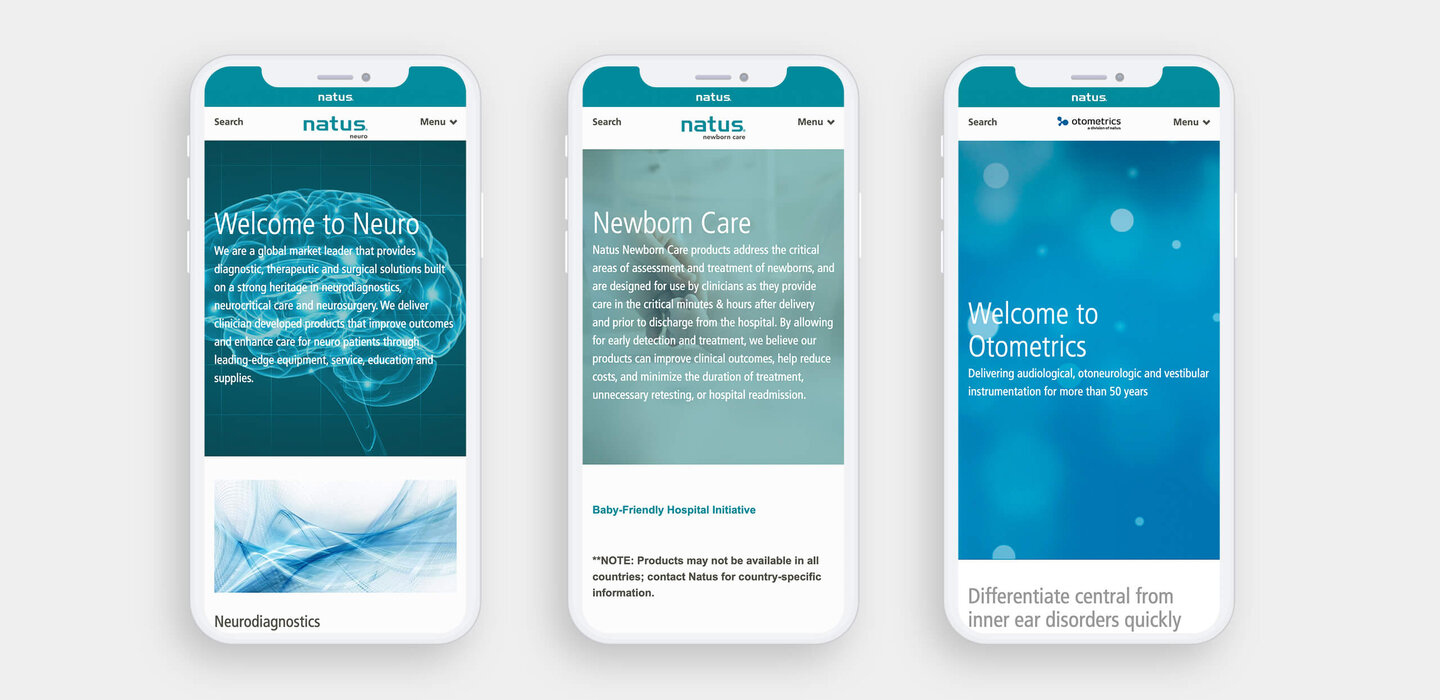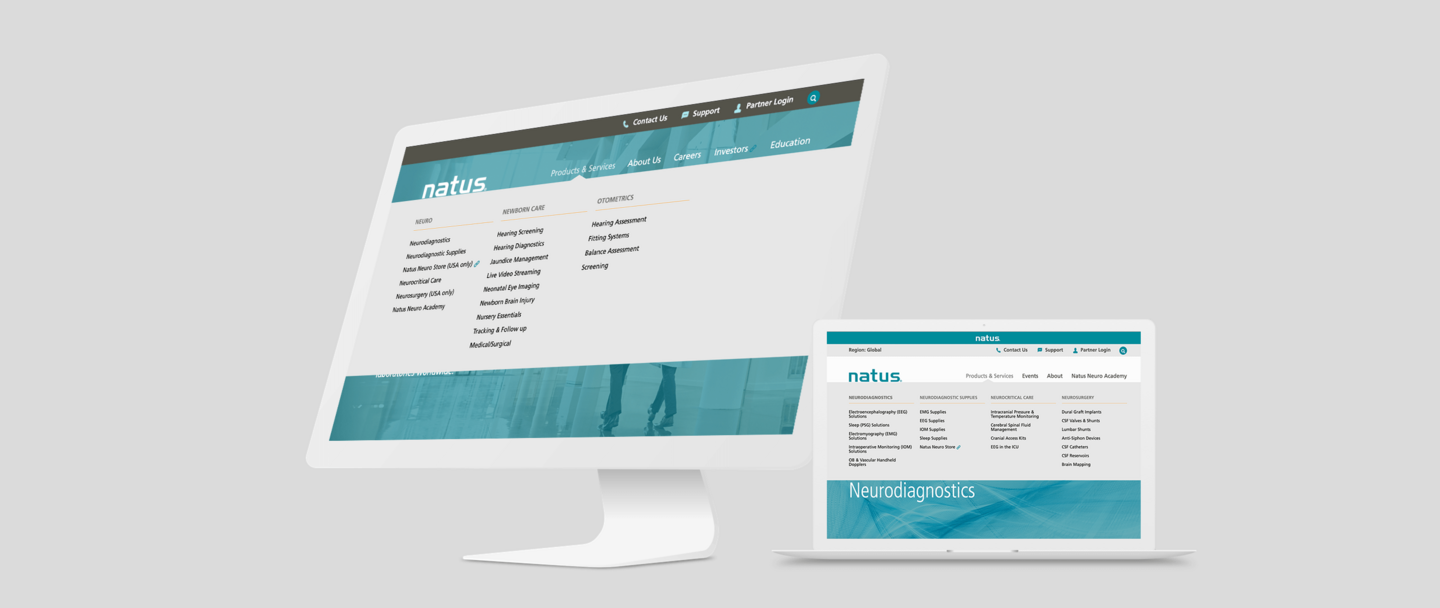Natus
Medical professionals around the world depend on Natus to monitor and track neurological dysfunction, epilepsy, sleep disorders, neuromuscular diseases, and balance disorders. Founded in 1987, Natus Medical Incorporated is a leading provider worldwide of medical products, software, services, education, and training.
In recent years, Natus has grown rapidly through acquisitions and disciplined channel development. To fortify its position as a thought leader, it was imperative that Natus present a unified brand platform across more than 20 different business sub-sites.
Time to make a change
Natus’ previous platform didn’t encourage recognition of the Natus brand or the company’s various business units. The site was simplistic and needed to be developed to allow for the complexity of Natus' business and to drive business goals.
A new platform from FFW helped Natus achieve the following goals:
- Quantifiable speed increase
- Traffic increase
- Streamlined sales tasks
- Stock price bump
Technology
- Cost of ownership and technical debt were both high
- Many of the properties were not adaptable for modern mobile needs
- Code base was different for all 21 sub-sites, that needed to be brought into alignment
Governance
- No centralized source of management or governance
- Complexities in process and structure were making it difficult to support internationalization strategy and multilingual needs
- Fragmented naming conventions were a constant source of confusion between sales and marketing teams
- Maintaining a single product catalog was considered ‘a moving target’
Branding and User Experience
- A variety of design and navigation structures created inconsistencies between brand experiences
- The content was not structured or written to speak to Natus’ broad range of customers
- The content was written for primarily for print collateral
- Products were difficult to find and difficult for content owners to maintain
Having built powerful Drupal platforms for GE, Panasonic and AMD, FFW was a natural partner to redesign the corporate website and establish a new digital platform for all of Natus’ strategic business units.
Crafting a strategy and roadmap
Natus wanted a platform that met measurable revenue and business goals while reducing cost of ownership. To accomplish this objective, the new platform needed to:
- Provide a centralized management and governance.
- Have functional tracking and reporting tools
- Enable a broad variety of visitors to quickly and easily access the information they need to make a purchase
On large and complex builds, it can be easy to focus on the technology and overlook the real source of value, which is customers and users. To prevent users’ needs from being neglected, a comprehensive digital strategy defined Natus’ long-term platform roadmap. This strategy needed to capture core business goals and align each business unit’s stakeholders with each other and with their audiences’ expectations.
To begin, FFW guided Natus stakeholders through a series of workshops exploring Natus’ brand, its digital audience, and its organizational goals.
The Natus brand
Though Natus is a massive organization with numerous business units, it was determined during the user research workshop that Natus’ customers have a much stronger affinity for Natus’ business units, rather than the parent brand. Because of this finding, each Natus business unit needed to retain its individual brand identity.
A lack of existing governance (combined with strict brand standards) made the Natus executives nervous about turning control over to each business unit. Part of FFW’s job for the redesign was to help Natus’ executives build processes and governance standards so that each business unit would fully stand up to the existing Natus brand.
The Natus audience
During the user research, it was determined that the various Natus websites should serve two distinct, target audience segments:
Medical workers and medical technology purchasers.
This audience enjoys working in their chosen field, is passionate about caring for patients, and needs a professional partner that will keep them up-to-date on industry trends and events.
Potential employees
Recruiting talented employees in all departments— from management and research personnel to software engineering— was identified as being key to Natus’ long-term success.




To serve the best possible experience to these two distinct target audiences, the Natus team reviewed and scored similar industry websites. The highest ranked pages displayed a strong high-tech sensibility, were easy to scan, had a clear navigation path, and provided quick access to product support.
Natus' business goals
The various Natus platforms weren’t optimized to address the large range of audiences that each business unit serves. Since each business unit had its own nuanced definition of a conversion, FFW asked each unit to rank those conversion initiatives from most to least important.
Armed with information, the FFW team used the audience research from earlier in the workshop to map user paths to help each business unit’s audiences achieve those conversions.
Implementing a solution
FFW began by constructing wireframes and style tiles to help the Natus stakeholders visualize the new platform and offer feedback. In-browser prototypes demonstrated exactly how the new website would look and behave, down to the micro-interactions, hover states, and animation effects on design elements.
An atomic design
To allow the different business units to have control over their branding and layouts while still adhering to the wider Natus standards, FFW created a component-based design. Each business unit uses the same library of components and templates, but is able to adjust attributes like color and layout.
The pattern library has a twofold benefit: First, it allows each business unit control over its individual sub-site and layout. Components can be moved, modified, and optimized to encourage acquisition, retention, and provide better customer service, while still drawing only on the existing codebase and adhering to Natus’ established visual standards. Second, the pattern library also streamlines the codebase for all of the sites, reducing technical debt and cost of ownership.
A refined information architecture
A convoluted user experience creates the wrong impression. A website that is difficult to navigate suggests that a company is equally difficult to work with. In many instances, the existing architecture of the Natus sites assumed that users were familiar with the Natus naming and product structure, which made products difficult to locate.
Using information on Natus’ audiences, their behavior, and their preferences, FFW refined Natus’ information architecture to make information easy to find. FFW evaluated Natus’ existing content, scored it for usefulness, relevance, and lifespan, and only the pages that FFW and Natus deemed to be valuable were migrated to the new site.
A large portion of content that was migrated included training materials. Natus had developed a deep catalog of training materials. Providing easy access to these educational resources was an important part of the overall strategy to solidify Natus’ position as a thought leader, and is essential to drive future revenue growth.
Beyond simply bringing clarity to Natus’ end users, having a streamlined information architecture provided the added benefit of creating a rubric through which all future companies and products can be assimilated. Knowing where a product or service lives within a multi-vertical business provides clarity throughout the organization while simultaneously enhancing SEO.
Launching for success
The new platform delivered on a number of Natus’ goals:
Technological improvements:
-
Reduced maintenance costs by consolidating independent sites onto a centralized platform
-
Created a plan for migrating and on-boarding new websites as additional corporate acquisitions are completed
Governance improvements:
-
Centralized governance and management of all website properties through a multi-site platform and atomic design
-
Supports an internationalization strategy by serving the unique attributes of countries and regions
-
A robust CMS now enables marketing stakeholders and non-technical staff to easily maintain and update content
-
A new publishing workflow provides version control and a tiered approval process
User experience improvements:
-
A flexible visual design system maintains Natus’ brand and provides a consistent user experience
-
A fresh information architecture provides clear and intuitive navigation for visitors, simplifying the process of finding product information
-
All brands are consolidated into a single, easy-to-maintain platform
-
A mobile-first responsive design ensures all business units are accessible across desktop tablets and smartphones, and aligns the brand to the needs of modern consumers